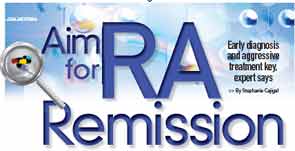
SANTA MONICA, CALIF.—The current state of rheumatoid arthritis (RA) treatment should include early diagnosis with an ultimate goal of remission, RA expert Paul Emery, MA, MD, said here on May 18 at the California Rheumatology Alliance 9th Annual Medical and Scientific Meeting.
Dr. Emery, professor of rheumatology and head of the academic unit of musculoskeletal disease at the University of Leeds in Leeds, U.K., opened his presentation by emphasizing the importance of early referral recommendations as a means of intervention.
At Leeds, for example, patients are referred by primary care physicians on the basis of new onset arthritis (nontraumatic) or symptoms of inflammation, including early morning stiffness or swelling or responses to nonsteroidal antiinflammatory drugs (NSAIDs). In fact, primary care providers are asked to refer patients on the basis of history rather than having them wait for test results.
“If they’d like to do the test, great, but don’t do the test and wait for the referral,” Dr. Emery said.
He noted that test results at this stage are likely to be negative. “Nearly the vast majority of patients will not have erosions,” he said. “CRP [C-reactive protein] won’t be raised in most of them, and only about 40% at this stage will have an autoantibody. As we begin to believe that the period of time before you start therapy is absolutely critical, then that’s not the way to handle patients, so primary care refers on the basis of history.”
If primary care physicians will not refer, Dr. Emery said he asks that they test for anticitrullinated protein antibodies (ACPA) and erythrocyte sedimentation rate (ESR) or plasma viscosity (PV), the latter two of which, he says, are more sensitive than a CRP test at onset. “You’ll find more patients who have raised ESR who have early onset,” he said.
Role of Guidelines
Dr. Emery also reviewed the impact of the ACR/ EULAR criteria for the classification of rheumatoid arthritis, pointing out there’s been a debate among rheumatologists about what RA actually is.
The 2010 criteria define RA as persistent small-joint arthritis, inflammatory arthritis requiring treatment with methotrexate (MTX), persistent synovitis with capacity to cause erosions as detected with an ultrasound, or intraarticular synovitis with erosions or precursors of erosions, such as osteitis, as seen on MRI.1
“The EULAR/ACR initiative was set up to have earlier identification of RA on the basis of a lot of data showing that early therapy was better and to differentiate from significant other pathology,” he said. “It used the requirement for MTX as a surrogate for diagnosis. Some people were very unhappy with that, but I think the new criteria have shown to be a valuable asset.”
Dr. Emery explained that, according to the ACR/EULAR criteria, the first step in determining if a patient has RA is using imaging to detect synovitis. The second step is to check for radiological erosion [indicative of more advanced disease], and the third uses a combination of variables to make the diagnosis, including joint involvement, serology, duration of synovitis, and acute phase reactants. According to the criteria, involvement of more than 10 joints, including small joints, has a very strong impact on a patient’s likelihood of having RA.
Dr. Emery said the criteria have removed the need for symmetry of joint involvement and presence of structural damage in order to diagnose patients and begin therapy. “If I told you that you had mild disease I think you’d want the best therapy,” he said. “You don’t not give antibiotics to a chest infection just because it’s not bilateral pneumonia.”
Being able to diagnose RA as an evolving disease is also positive for drug development, he said. “Drugs can now be developed and licensed at this early stage, whereas you used to have to call it pre-RA and I can tell you the FDA [Food and Drug Administration] was just not interested. Now it’s RA and they are.”
But the criteria aren’t perfect, Dr. Emery said. For example, imaging synovitis and erosion isn’t very straightforward. “For our typical patient, a middle-aged female with puffy hands, it’s extremely difficult to know if its synovitis or extraarticular soft tissue,” he said. “What you want to know is what’s in the joints and I think, ultimately, we should have imaging as part of our criteria.”
Dr. Emery referenced a study from 2010 that assessed the role of power Doppler ultrasound in an early inflammatory cohort and involved the development of a diagnostic algorithm for prediction of persistent inflammatory arthritis.2 Researchers found in that patients with one or two positive predictors, power Doppler ultrasound increases the probably of identifying persistent inflammation from 4%–27% to 69%–95%.
The study, he said, suggests the main role for ultrasound in diagnosed inflammatory arthritis is in patients who are seronegative.
Getting to Remission
Dr. Emery pointed out that the 2012 ACR recommendations set the target for disease activity as either remission or low disease activity.3 Getting there, however, is complicated.
For one, treating mild patients less aggressively may not be very effective. “If you allow methotrexate [MTX] to be given in the presence of inflammation eventually you can change the signaling molecules within the cells which make that individual much more resistant to later therapy,” he said.
He noted that the 2012 ACR recommendations indicate that a patient’s DMARD should be switched if he or she has low disease activity after three to six months of DMARD monotherapy or if the patient has at least moderate disease activity after three months of MTX. The guidelines indicate that a biologic should be added in cases of low disease activity and poor prognosis or moderate disease activity after three to six months of MTX monotherapy or DMARD combination therapy. Switching between biologics should be done with at least moderate disease activity after three to six months after failing an anti-TNF biologic, the guidelines state.
But Dr. Emery referenced several studies showing that a first-line biologic may offer higher remission rates and that if a target is not reached at six months, biologics are better than DMARDs. These include studies showing that treatment with adalimumab plus MTX is more effective than treating with MTX alone and that treatment of early RA with etanercept and MTX leads to clinical outcomes not seen with MTX alone.4-6
Although making sense of all the data out there isn’t easy, the main points are that early diagnosis is key and remission correlates with long-term benefits, Dr. Emery said. “We only have the luxury of maintenance therapy if we actually induce something with a more aggressive approach,” he said.
Stephanie Cajigal is a medical journalist based in California.
References
- Aletaha D, Neogi T, Silman A, et al. 2010 Rheumatoid arthritis classification criteria: An ACR/EULAR collaborative initiative. Arthritis Rheum. 2010;62:2569-2581.
- Freeston JE, Wakefield RJ, Conaghan PG, Hensor EM, Stewart SP, Emery P. A diagnostic algorithm for persistence of very early inflammatory arthritis: The utility of power Doppler ultrasound when added to conventional assessment tools. Ann Rheum Dis. 2010;69:417-419.
- Singh JA, Furst DE, Bharat A, et al. 2012 Update of the 2008 American College of Rheumatology recommendations for the use of disease-modifying antirheumatic drugs and biologic agents in the treatment of rheumatoid arthritis. Arthritis Care Res (Hoboken). 2012;64:625-639.
- Kavanaugh A, Fleischmann RM, Emery P, et al. Clinical, functional and radiographic consequences of achieving stable low disease activity and remission with adalimumab plus methotrexate or methotrexate alone in early rheumatoid arthritis: 26-week results from the randomised, controlled OPTIMA study. Ann Rheum Dis. 2013;72:64-71.
- Detert J, Bastian H, Listing J, et al. Induction therapy with adalimumab plus methotrexate for 24 weeks followed by methotrexate monotherapy up to week 48 versus methotrexate therapy alone for DMARD-naive patients with early rheumatoid arthritis: HIT HARD, an investigator-initiated study. Ann Rheum Dis. 2013;72:844-850.
- Emery P, Kvien TK, Combe B, et al. Combination etanercept and methotrexate provides better disease control in very early (<=4 months) versus early rheumatoid arthritis (>4 months and <2 years): Post hoc analyses from the COMET study. Ann Rheum Dis. 2012;71:989-992.
